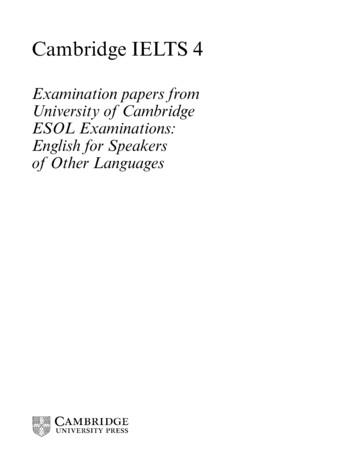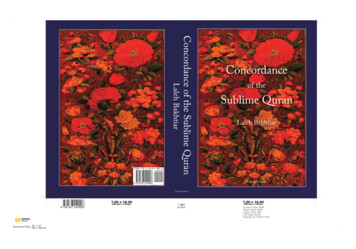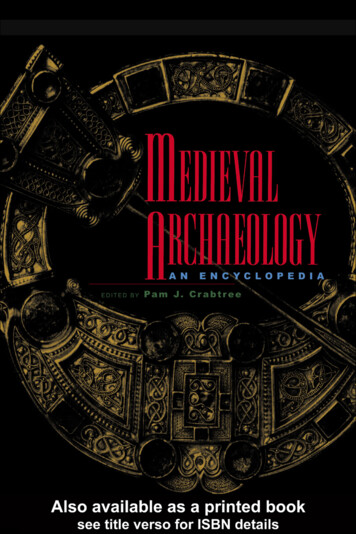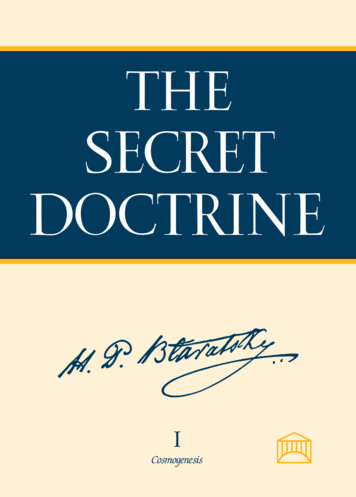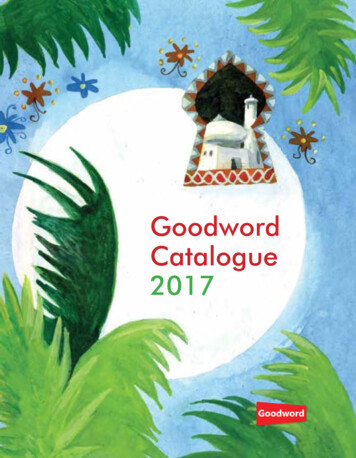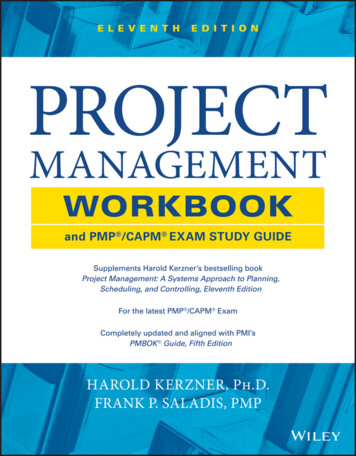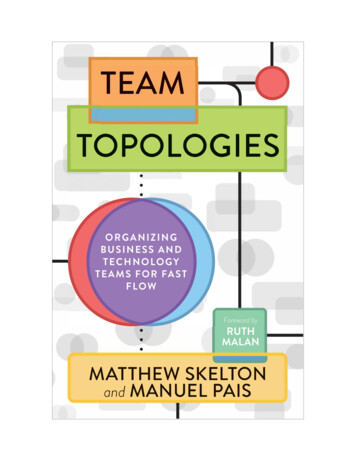
Transcription
Editorial Director: Allan AscherSeries Editor: Stella ReillyDevelopment Editors: Susan Ianuzzi, Janet JohnstonDirector of Production: Rhea BankerAssociate Director of Electronic Production: Aliza GreenblattProduction/Design Manager-Multimedia: Paul BelfantiElectronic Production Editor: Carey DaviesManufacturing Manager: Ray KeatingArt Director: Merle KrumperCover Coordinator: Merle Krumper, Eric DawsonIllustrators: Carlotta Tormey, Matthew Daniel, Betsy Day, Andrew Lange, Shelly Matheis,Gabriel Polonsky, Len Schalansky, Catherine Doyle SullivanRealia: Carey Davies, Eric Dawson, Steven Greydanus, Michelle LoGerfo, Wendy WolfInterior Design: Eric DawsonCover Design: Carmine Vecchio 2000 by Prentice Hall RegentsA Pearson Education CompanyWhite Plains, NY 10606-1951All rights reserved. No part of this book may bereproduced, in any form or by any means,without permission in writing from the publisher.Printed in the United States of America10 987654321ISBN 0-13-096478-6Prentice-Hall International (UK) Limited, LondonPrentice-Hall of Australia Pty. Limited, SydneyPrentice-Hall Canada Inc., TorontoPrentice-Hall Hispanoamericana, S.A., MexicoPrentice-Hall of India Private Limited, New DelhiPrentice-Hall of Japan, Inc., TokyoPearson Education Asia, SingaporeEditora Prentice-Hall do Brasil, Ltda., Rio de JaneiroReviewers: Peggy Armstrong, Kaplan Educational Services; Leslie Biaggi, Miami-Dade Community College; Ulysses D’Aquila,City College of San Francisco; M. Sadiq Durrani, BNC Santa Cruz; Kathy Hamilton, Elk Grove Adult Education; Peter Jarvis, NewYork City Board of Education Adult Division; Kevin Keating, University of Arizona; Margaret Masterson, Bethune Middle School;Joanne Mooney, University of Pennsylvania; Janet K. Orr, Shanghai Centre, Beijing; Cheryl Pearson, University of Houston;Randy Schafer, Free-lance Instructor, Japan; Tammy Smith-Firestone, Edgewood Language Institute; Maria Rita Vieira, YazigiLanguage Schools, Brasilii
ContentsUNIT 1Lesson 1Lesson 2Lesson 3I’m studying in California.Do you have anything to declare?From One Culture to AnotherUNIT 2Lesson 1Lesson 2Lesson 3You changed, didn’t you?Do you remember . . . ?Women’s Work131720UNIT 3Lesson 1Lesson 2Lesson 3We could have an international fall festival!You are cordially invited.Fall Foods252932UNIT 4Lesson 1Lesson 2Lesson 3Excuses, excuses!You value creativity.What is your learning style?374144UNIT 5Lesson 1Lesson 2Lesson 3Is this the way to the festival?Come to the Winter Fantasy Festival.Yon Mi’s Journal495356UNIT 6Lesson 1Lesson 2Lesson 3Don’t try to talk with that sore throat.A Healthy DietAlternative Medicine616568UNIT 7Lesson 1Lesson 2Lesson 3I planned to buy the smallest TV in the store.I don’t have enough cash.Can you save money when you spend money?737780UNIT 8Lesson 1Lesson 2Lesson 3Have you paid the tuition bills yet?I want to open a checking account.Each dollar is a piece of your work.858992UNIT 9Lesson 1Lesson 2Lesson 3I’ll be glad to give you a recommendation.Careers for MultilingualsLynn’s Résumé97101104UNIT 10Lesson 1Lesson 2Lesson 3Something wonderful will happen soon.What will you do if you have the time?What will you remember them for?109113116Tapescripts158T121iii
UnitFunctions1Getting to Know PeopleIntroductions; greetings; forms ofaddress; classroom behavior; customs; traditions; culture shock;current/ongoing activitiesMaking formal and informal introductions and greetings; asking forpersonal information; describing actions in progress; using appropriatebehavior in social situations; asking for confirmation; confirming astatement; engaging in small talk; reading for specific information;talking about everyday activities, customs, and traditions2The Past and Past ExperiencesChildhood; personal events in thepast; historical events; changingroles of men and women; pioneersand explorersSequencing events; asking about the past; talking about past experiences; comparing past and present; describing personal life events;asking for confirmation about past events; reading a short magazinearticle; discussing historical events and achievements; writing a simpleautobiography3Invitations and MessagesHomesickness; holidays; phoneuse; invitations; responses; leisureactivities; reminiscing; the rightthing to do in social situationsTalking about possibility; issuing invitations; accepting and declininginvitations orally and in writing; leaving and taking a telephone message; writing down a message from an answering machine; talkingabout ongoing past activities; reading for general and specific information; talking about the right thing to do in social situations4Culture and PersonalityVariations Excuses; classroombehavior; school policies; abilities;personality types; academic goals;interests; learning stylesMaking excuses; comparing classroom behaviors in different cultures;reading about and discussing school policies; identifying personalitytypes; identifying abilities and talents; talking about personal and academic goals; making predictions about the future; discussing learningstyles; writing about future goals5A Town in the United StatesDirections; the neighborhood; holidays; community resources; pastand present; comparing two cities;the ideal cityTalking about places in a neighborhood; asking for and giving directions; comparing two places in a town or city; reading for specificinformation; talking about holidays; talking about past habits and customs; writing a journal entry; describing differences between two cities6Healthy Living TodayHome remedies; doctors’ appointments; health advice; preventiveand alternative medicine; healthyliving; nutritionTalking about health problems and remedies; making suggestions;making a doctor’s appointment; giving advice; discussing a healthydiet; talking about food; planning a balanced meal; listening to adviceand taking notes about a healthy diet; reading about alternative medicine; writing a short report7The Price of Convenience andComfort Stores and shopping;exchanging and returning; advertising; consumer scamsTalking about purchases; writing a letter of complaint; exchanging apurchase; comparing features of stores and items; making a catalogpurchase; giving reasons for returning a purchase; analyzing an ad;writing an adMoney MattersCredit cards; opening a checkingaccount; the American consumerTalking about budgets; talking about past actions; opening a checkingaccount; calling an account information line; recording information in acheck register; comparing budgets; interpreting a pie chart; listening toa radio broadcast for specific details; making a food budget; reading anewspaper articleThe Job MarketConflict on the job; employmentads; job search strategies; therésuméAsking for and writing a letter of recommendation; matching skills andqualities with job requirements; reading employment ads; discussingdesirable jobs; calling about an advertised job; identifying parts of arésumé; writing an employment adWhat the Future HoldsPredictions; memories; futureplans and goalsTalking about predictions; making promises; talking about future goalsand possibilities; sharing memories; predicting future events; talkingabout future plans8910ivTopics
Grammmar andPronunciationCommunication SkillsLISTENING AND SPEAKINGREADING AND WRITING Simple present vs. present continuous; affirmative and negativetag questions and shortresponses: do/does and is/are Tag questionsMake introductions; ask for personal information; talk about everyday activities; talk aboutappropriate classroom behavior; confirm astatement; engage in small talk; discuss traditions and customsRead for specific information;set up a personal journal Simple past: regular/irregularverbs; affirmative and negativestatements; yes/no, Wh-, past tagquestions and responses Irregularverbs: the present and past formsSequence events; ask about the past; comparethe past and present; describe personal lifeevents; ask for confirmation; discuss historicalevents and achievementsWrite a paragraph; make a timeline; read a short magazinearticle; write a simple autobiography; revise written material Modals: can, could, may, might,should and their negatives; pastcontinuous: affirmative statementsand yes/no questions andresponses Reduced syllablesTalk about possibility; invite someone byphone; accept and decline an invitation orally;leave and take a telephone message; talk aboutongoing past activities; talk about the rightthing to do in social situationsWrite a message from ananswering machine; write predictions; write an invitationand a response to an invitation;read a newspaper article Modals: have to, had to, mustand their negatives, may (permission); object pronouns; futurewith going to Minimal pairs: [b] [p]Make excuses; compare classroom behavior indifferent cultures; discuss school policies; talkabout personal and academic goals; makefuture predictions; discuss learning stylesRead about school policies;write about goals; complete alearning style questionnaire;identify personality types;describe yourself in writing Comparative adjectives: regularand irregular; used to: affirmativeand negative statements andyes/no questions and shortresponses Minimal pairs: [b] [v]Talk about places in a neighborhood; ask forand give directions; compare two places in atown or city; talk about holidays; talk aboutpast habits and customs; describe differencesbetween two citiesWrite a paragraph; read forspecific information; write ajournal entry about goals Imperatives: affirmative andnegative; verbs followed byinfinitives Statement or question?Talk about health problems and remedies; makesuggestions; make a doctor’s appointment; giveadvice; discuss a healthy diet; talk about preferences, likes, and dislikes in food; listen toadvice about a healthy dietTake notes; read about alternative medicine; write a shortreport; read and answer lettersasking for advice; write aboutan illness or accident Compound sentences: and, or,but, so; superlative adjectives: regular and irregular; comparisonswith as . . . as Minimal pairs: [b] [d]Talk about purchases; exchange a purchase;compare features of stores and items; make acatalog purchase; give reasons for returning apurchase; role play business transactions; listento television adsWrite a letter of complaint; analyze an ad; write an ad for aschool; write about fashion,television ads, desirable products, and comparing stores Present perfect: statements withalready, yet, with have/has questions and responses; too/either;contractions Full forms andcontractions with haveTalk about budgets; talk about past actions;open a checking account; call an account information line; listen to a radio broadcast for specific details; listen to information about budgetsRecord information in a checkregister; compare and make budgets; write about learningEnglish, credit cards, and savingmoney; make a “to do” list Complex sentences with before,after, when, because Minimal pairs:[θ] thank / [t] tankAsk for a letter of recommendation; discussdesirable jobs; call about an advertised job;listen for information about a job and a jobinterview; role play an interviewWrite a letter of recommendation; read and write employment ads; write about skillsand abilities; read about careers Simple future: will; will withyes/no questions and responses;real conditional: if-clauses; possessive pronouns Contractions with willTalk about predictions; make promises; talkabout future goals and possibilities; share memories; predict future events; talk about superstitionsWrite about predictions, superstitions, and goalsv
IntroductionWelcome to VOYAGES. This five-level course givesadult and young-adult learners a comprehensive setof communication skills in the English language.Throughout each level, language is natural andauthentic, and contextualized in lively, interestingsituations with which your students can easilyidentify. The lessons in VOYAGES presuppose thatits users are motivated by factors typical of adults,making the series appropriate for students who arehigh school age and older. Each lesson challengesstudents by capitalizing on what they know or havelearned, and by encouraging them to stretch just alittle beyond their current stage of languagedevelopment. With each new step, students aregiven a firm grammatical basis on which to buildtheir communication skills.THE COMPONENTSOFVOYAGESEach of the five levels of VOYAGES includes fourcomponents to make your students’ learningexperience interesting and successful.1. The Student Books consist of ten units each. Eachunit is divided into three separate lessons. Lessons1 and 2 introduce new language through dialogs,readings, conversation practice, and task-basedactivities. Grammar is treated inductively asstudents first use new structures to complete simplecommunication tasks, and subsequently have theirattention drawn to those structures. Lesson 3integrates and expands the functions and structurestaught in Lessons 1 and 2, and directs the studentstoward a more personalized use of English. At theend of each unit all grammar, vocabulary, andcommunication skills are summarized. Each levelprovides enough activities for approximately sixtyclass sessions of 50 minutes each. The material canbe extended to ninety class sessions by usingcorresponding Workbook exercises and activitiessuggested in the Teacher’s Resource Manuals.One of the innovative features of VOYAGES is aseries of exercises called “Strategies for Success,”found at the end of each unit in Books 1 through 4.These sections are designed to encourage students to do something on their own, beyond theclassroom, to improve their skills;viIntroduction become aware of some of the techniques thatsuccessful language learners have used toachieve their highest potential; work with another student, a learning partner,in a cooperative venture to practice English andreflect on their learning; and write entries in a personal journal to reinforcetheir English skills, and, starting in Book 2, toreflect on their learning styles, their strategyuse, and their progress in English.Your encouragement and guidance of yourstudents is an important factor in making the“Strategies for Success” exercises doable andpractical. Research has found that if students aresimply told to do these exercises if they want to,only a very small number of students will do so.So what is needed is your conviction that students can gain significantly from performingself-help exercises outside the classroom; making some effort on their own—without theteacher there for every step—develops students’autonomy and pride in their accomplishments; doing the exercises in a low-risk setting with alearning partner will increase their motivationto learn English; writing in a personal journal helps to reinforcelanguage skills.In other words, if you convey your own positiveoutlook on strategy training and help yourstudents to get started, they will be interested andchallenged to perform the exercises.2. The Teacher’s Resource Manuals provide clearprocedures for teaching each page of the StudentBook. First, an overview lists the topics, grammar,and communication skills covered in each unit.Then, step-by-step instructions for deliveringclassroom lessons are given. Also included areexplanations of grammar points, pronunciationpointers, information on cultural topics, tapescripts,answers for each exercise, optional activities forfurther practice, and specific suggestions forimplementing the “Strategies for Success” modules.Each Teacher’s Manual for levels 1–4 includes a set oftests: one mid-term (covering units 1–5) and one
final (covering units 1–10). Each test is accompaniedby directions to the teacher for administration andscoring. A unique feature of the Student Placementand Evaluation Test is that it includes sections onspontaneous oral and written production.button allows for better maintenance of the sitethrough teachers’ and students’ feedback. Onlineactivities are indicated in the Student Book with asymbol.The Teacher’s Resource Manuals are designed so thatteachers new to the field will find all the informationthey need to become immediately successful in theclassroom. More experienced teachers will find awealth of suggestions to add to their repertoires.FEATURES OF THE VOYAGESSTUDENT BOOK3. The Workbooks include a variety of exercises tobe used either for homework or for extraclassroom practice. The exercises strengthen thestudents’ competence in English and provideadditional interest and motivation. The answers tothe Workbook exercises are provided at the end ofeach unit of the Teacher’s Resource Manual.4. The Audio Programs contain recordings ofdialogs, listening-comprehension exercises, andother exercises for which hearing examples andmodels can enhance students’ learning. Exercisesare recorded at normal conversational speed, usinga variety of native speakers of English, so thatstudents can build their listening skills and practicecorrect pronunciation. Recorded exercises areindicated in the Student Book with asymbol.5. The Companion Website is an online feature new tothe VOYAGES program. Ten online unitsaccompany the Student Book. Each unit consists ofclearly stated activity “Objectives”; “Web” activitiesthat facilitate exploration of unit themes within amultisensory learning environment; “E-mail”activities that prompt students to “talk”about unitthemes by corresponding to a pen pal, encouragingstudents to use unit vocabulary and grammaticalstructures in a meaningful context; “Grammar”activities that feature instant scoring and feedbackso students will recognize their strengths andweaknesses immediately. The site also features a“Teacher Notes” section, which includes Vocabulary,Wrap Up, and Putting It Together sections, andadditional links to help facilitate student learning.The entire Teacher’s Resource Manual is availableonline for download. Navigating through thewebsite is simplified through easily identifiedbuttons. The “Preferences” button helps to managestudent performance by having students e-mail allof their answers to the teacher and to themselves forfollow-up activities. The “Help” button providessupport to the companion website. The “Feedback”Each lesson opens with an attractive illustrationand a presentation of an authentic conversation orreading. Exercises provide students with varied,interesting tasks that are authentic, creative, andinteractive. New vocabulary in the unit is systematicallypracticed in a section called “Word Bag.” Sections called “Hear It. Say It.” focus onpronunciation. Special new sections labeled “Strategies forSuccess” show students how to use learningstrategies outside the classroom. Another new feature, an “Online” section,introduces students to simple Internet activities. Sprinkled through the units are various culturalnotes and information pieces. The “Wrap Up” exercise is a personalizedactivity that culminates each unit. Two new self-check sections at the end of eachunit help students to evaluate their learning(“Checkpoint”) and to think about theirlearning modalities (“Learning Preferences”). Summary pages at the very end of each unitsummarize the vocabulary, grammar, andcommunication skills covered in that unit.FEATURES OF THE VOYAGESTEACHER’S RESOURCE MANUAL A Unit Overview listing (a) topics, grammar, andcommunication skills and (b) skills standardsusing CASAS and SCANS competencies. Step-by-step, explicit instructions for takingstudents through each exercise. An Answer Key for each exercise. Tapescripts for all audiotaped material. Answers to Workbook exercises.Introductionvii
All the materials for the mid-term test (see Unit 5)and for the final test (see Unit 10). These include:(a) photocopy-ready student test pages(b) complete directions for administration(c) tapescripts for listening comprehensionsections(d) instructions for scoring and a scoringsummary sheet(e) answer sheets and answer keys.BACKGROUNDCASASONSCANSANDThe SCANS and CASAS skill standards are careerand vocational goals advocated by the federalgovernment and by the State of California to preparestudents for the demands and challenges of theworkplace. These skills standards constitute aprogressive series of levels of proficiency in languageand communicative functions, as well as a generalintroduction to the technological and interpersonaldemands of the international workplace.In 1990 the Secretary of Labor appointed a groupcalled the Secretary’s Commission on AchievingNecessary Skills (SCANS) to determine the skillspeople need to succeed. The commission wascomposed of 30 representatives of education,business, labor, and state government. It wascharged with defining a common core of skillsthat constitute job readiness in the currenteconomic environment.Under separate auspices, the State of Californiaappointed an advisory committee in 1983 to helpimprove education in its primary and secondaryschool system. In 1988 the state superintendent ofpublic instruction broadened the scope of thisinitiative, appointing an adult education advisorycommittee as well. Their report, entitled AdultEducation for the 21st Century: Strategic Plan to MeetCalifornia’s Long-Term Adult Education Needs, extendsCalifornia’s educational mandates to include ESLprograms for adults. The criteria in the Strategic Planform the foundation of English-as-a-second-languageModel Standards for Adult Education Programs.The Comprehensive Adult Student AssessmentSystem (CASAS) is a widely used system forassessing adult basic skills within a functionalcontext. It has been approved and validated by theviiiIntroductionU.S. Department of Education in the area of adultliteracy. CASAS provides a framework forimplementing quality programs with a built-instandardized accountability system for reportingresults. The assessment, training, and evaluationare based on the critical competencies and skillareas required for success in the workplace,community, and family.Each VOYAGES Teacher’s Resource Manual displaysa Skill Standards Overview at the beginning ofevery unit so that educators and administratorscan determine at a glance which competencies andskill standards are addressed within a particularunit of the Student Book.THE VOYAGES APPROACHVOYAGES features the best of what has come to beknown as “communicative language teaching,”including recent developments in creatinginteractive, learner-centered classrooms. VOYAGESprovides students with natural, meaningfulcontexts in which to practice the communicativefunctions of the language. As such, it emphasizesthe internalization of language structures andfunctions through practice in using the languagefrom the very first day. VOYAGES deemphasizesthe use of grammar rule memorization,overlearning, translation, and teacher-centeredactivities. When grammar practice and explanationsoccur, they are kept simple and are alwaysembedded in real, communicative contexts.VOYAGES emphasizes practice in all fourlanguage skills. In the process of helping studentsto acquire their new language, the teacher acts as afacilitator and guide in a student-centeredclassroom. The ultimate goal of this series is toprovide students with the fluency needed to useEnglish in unrehearsed situations outside theclassroom. How is this goal achieved?1. By presenting language in meaningful,communicative, and functional contexts.VOYAGES emphasizes using language functionsin meaningful, communicative contexts and notusing individual structures, forms, or sounds inisolation. Dialogs are used not for rotememorization, but for adaptation to pair andsmall-group work. And rather than focusing on
mastery through memorization, “overlearning,”and drilling, VOYAGES places emphasis onstudents’ attempts to communicate spontaneously,even if those attempts have errors in them.Students are encouraged to take risks and to use atrial-and-error approach as they try out their newlanguage. Class work is learner-directed so thatstudents gain confidence and eventually attainfluency and accuracy in the language.Grammatical structures have their place inVOYAGES too, but not as isolated patterns foranalysis and rule memorization. Instead, allstructures are taught within a functional andcommunicative context. As students progressthrough units that are grammatically sequenced,they practice functional language that enablesthem to accomplish specific communication goals.In this way, students have a chance to use thelanguage at the same time as they learn about itsstructures and functions.Each unit helps students do things with thelanguage they are learning—to use the naturalfunctions of language in familiar, meaningfulcontexts. For example, they may learn to greetsomeone (“Hello. How are you?”), to ask forinformation (“What time is it?”), to make asuggestion (“Let’s go to a movie tonight”), to givean opinion (“I think he’s happy because he doesn’thave to get up early”), and so on.VOYAGES provides a wide range of opportunitiesfor English language practice. This is achievedthrough student/teacher interaction and a great dealof pair and small-group work in which studentsexpand on structural and functional models andthus gradually learn to express themselves creatively.2. By encouraging the integration of allfour language skills.Certain language teaching methods defer teachingreading and writing until speech is mastered.VOYAGES advocates the use of all four languageskills—listening, speaking, reading, and writing—from the very first lesson. Each unit includesactivities in each of these skills areas. Emphasis isplaced on listening activities as one of the mainsources of comprehensible input for the student;therefore, tape recordings and tapescripts withmeaningful and communicative contexts areprovided for every lesson. The naturalinterrelationship of the four skills is exploited anddeveloped. For example, a spoken answer followsa spoken question, a written response may followthe reading of a letter, and so on.3. By focusing on student-centeredlearning with the teacher as facilitator.VOYAGES encourages teachers to be more thefacilitators of the students’ language acquisitionprocess and less the directors of a language class—to be less directive, but no less effective. Thismeans motivating students to grasp the languagethrough their own involvement in a meaningfuland communicative process, which necessarilyinvolves risk-taking and trial and error.VOYAGES is a student-centered series; it focuses onstudent “ownership” of the English they arelearning from the very first lesson. Once studentshave been initially exposed to correct languagemodels, they are expected to take the lead in usingthem. For example, in the Teacher’s Resource Manual,the students, not the teacher, ask the questions,write the answers on the board, give the dictations,and so on. Exercise instructions frequently specifythat students work in pairs or small groups notonly to practice a given conversation pattern butalso to expand on it creatively. The teacher’s role isgenerally that of a facilitator and monitor of thelanguage learning and acquisition process. Ofcourse, you are expected to be in charge of theoverall syllabus and how it flows, but you need notdirect all the activities at all times.Above all, VOYAGES encourages students tocommunicate creatively. Lesson 3 of every unit hasstudent-centered activities that motivate thestudents to integrate and apply in an originalmanner the skills and content they’ve learned inLessons 1 and 2. For example, exercises havestudents “Write a postcard . . . ,” “Interview aclassmate . . . ,” and so on.4. By assigning a secondary role tostructural information and a minor roleto translation.In Getting Started, structural (communicative)information is summarized at the end of each unitbecause research has demonstrated that studentsshould first receive meaningful and communicativepractice in the target language. Translation ofvocabulary items or whole phrases and structuresinto a student’s native language should be resortedto only if other means, such as paraphrasing,Introductionix
gesturing, and using visuals and diagrams, havefailed to get the message across. In this way, studentswon’t come to depend on their native language as acrutch. Research shows that frequent or excessivetranslation can markedly slow students’ progress.GUIDELINES AND SUGGESTIONSUSING VOYAGESFORThe following are some guidelines and suggestionsfor using VOYAGES by skill area, with additionalnotes on grammar and vocabulary. More specifictips on classroom activities in all of these areas areprovided in the Teacher’s Resource Manuals.ListeningAll of the listening activities in VOYAGES arerecorded on cassette, with tapescripts in theTeacher’s Resource Manual. As a general rule, usethe following procedure for listening exercises.1. Preview the context of the listening exercise bydiscussing where the conversation takes place,who the speakers are, and the purpose of theconversation. You might write new vocabularyitems on the board and check to see if yourstudents understand them. It is important, though,to remind students that the usual goal of alistening activity is to remember not the specificwords or structures, but the main idea(s).2. Make sure that students know exactly whatthey are expected to listen for: grammatical cues,particular vocabulary items, specific information,overall meaning, or all of these? Before you begin,be sure to give students an opportunity to ask youany questions about the exercise.3. Play the cassette or read the tapescript (in anormal, conversational tone) as many times asyou think necessary. Students often gain“comprehension confidence” through repetitionof material.4. Allow the students time to give their responsesto a listening activity. The recordings leave amplepauses for this purpose. Students respond bywriting the answers in their books, on separatepaper, or on the board, or by answering orally.5. Sometimes it’s necessary to play th
iii UNIT 1 Lesson 1 I’m studying in California. 1 Lesson 2 Do you have anything to declare? 5 Lesson 3 From One Culture to Another 8 UNIT 2 Lesson 1 You changed, didn’t you? 13 Lesson 2 Do you remember . . . ? 17 Lesson 3 Women’s Work 20 UNIT 3 Lesson 1 We could have an international fall festival! 25 Lesson 2 You are cordially invited. 29 Lesson 3 Fall Foods 32

